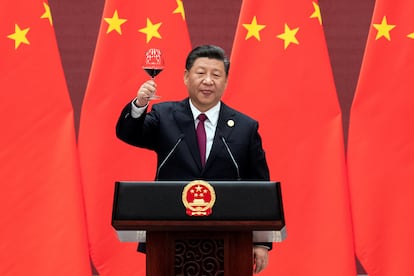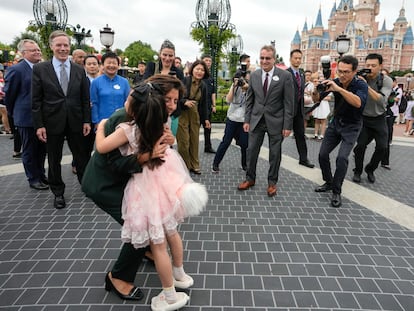The New Silk Road, China’s controversial great strategic plan, turns 10 years old
Beijing defends a decade of global benefits from the program, but critics warn of spiraling debt for developing countries


On September 7, 2013, exactly 10 years ago, the President of China, Xi Jinping, approached the microphones in a spacious room at Nazarbayev University, in Astana (now Nur-Sultan), the capital of Kazakhstan. He began his speech by recalling the travels of Zhang Qian, an emissary whom Emperor Wu of the Han Dynasty sent on a journey through Central Asia more than 2,100 years ago. “His voyages,” Xi said, “opened the door to friendly contact between China and the countries of Central Asia, and gave rise to a Silk Road linking East and West, Asia and Europe.”
He then outlined a proposal that would mark his next decade as leader of China. It was an idea conceived to expand the Asian economic giant beyond its borders and in line with the “new era” that he envisioned for his country, with the aim of increasing its weight on the geopolitical board. “So that all Eurasian countries can enjoy closer economic ties, deeper cooperation, and greater space for development, we can use an innovative model of cooperation, jointly building an economic belt along the Silk Road,” he said.
Thus, a modern Silk Road was born.
The speech given by Xi in Kazakhstan is considered the founding document of the Belt and Road initiative, the official name of the infrastructure mega-program with which China seeks to connect to the world. The strategic plan celebrates its tenth anniversary this Thursday with a controversial report card: for Beijing, which has invested around $1 trillion in more than a hundred countries, it is a “high-quality asset, built by the parties involved and shared by the world,” said the still-missing former Foreign Minister, Qin Gang, in March at his one and only press conference. For others, however, it is “China’s route to ruin,” as defined by researchers Michael Bennon and Francis Fukuyama in a recent article in the journal Foreign Affairs. In it, they assert that Beijing’s tentacular program endangers numerous developing countries, trapped in a spiral of debt with China and compromises the International Monetary Fund, which will have to step in to rescue them.
In October, the Chinese government plans to hold the 3rd Belt and Road Forum and expects various leaders to visit, including the Russian President Vladimir Putin. It certainly makes you think about how much the world has changed in 10 years. When Xi gave that speech, the planet was emerging from the shock of the Great Recession, and a global pandemic was still the stuff of science fiction movies. Likewise, relations between Beijing and Washington had not gone into a tailspin, the Chinese president had been in office for less than six months and at another conference with the G20 leaders in Saint Petersburg only a few days before: he warned of a wave of protectionism that was beginning to sweep the planet and called for more globalization. The world was so different that the Russian President Vladimir Putin hosted the G20 summit in his hometown. He is now banned from the organization and an arrest warrant from the International Criminal Court weighs over him. Only a few months later, he decreed the annexation of Crimea, which cast a looming shadow until the invasion of Ukraine in February 2022.
Agreements with 150 countries
Over the next decade, China would invest in all types of logistics, energy, and infrastructure projects around the globe. And this deployment by Beijing would soon send warning signals in Washington and Brussels. Currently, more than 150 countries have signed Belt and Road cooperation agreements (about two-thirds of the world’s states), according to China, including a good number of EU partners. Spain is not among them, nor is Germany or France. But Italy is: it is the only member of the G7 that has signed a memorandum of understanding, although it is unlikely to last long.
Last Monday, Antonio Tajani, the Italian Foreign Minister, was on an official visit to Beijing. In his high-level meetings he omitted the topic, according to the official reading, but just before the trip he stated that the Belt and Road project “had not delivered the expected results.” The Italian Prime Minister, Giorgia Meloni, already stated during her election campaign that joining the program had been “a big mistake.” In conclusion: “Italy is heading towards a break with the Chinese Belt and Road initiative,” according to a memo by Trivium China analysts. But neither side wants to make too much of a fuss. “Everyone wants to stay friends.”
The proposal has functioned as an umbrella with which Beijing has increased Chinese demand abroad (its companies and workers have often participated in the construction of projects) while attracting enormous energy resources inland. For example, Xi closed substantial agreements on hydrocarbons on his trip to Astana in 2013. Although projects of all kinds fit under the initiative, from security to culture: during the last 10 years, China has started the first major archaeological excavations outside its borders.
A café between China and Kazakhstan
Money has also permeated the Asian giant, giving rise to modern caravanserais (roadside inns) in the middle of nowhere. Lucia Hu, a Chinese woman who for years was an immigrant to Italy, prepared an espresso last June that was almost impossible to find for miles around. The place is called The Silk Road Café and is located in the Horgos International Cooperation Center, a free trade zone located on the border between China and Kazakhstan, not far from the ancient commercial roads. Technically, it consists of a fenced mini-city, between both countries, where citizens from both sides can enter, take a photo with one foot in each state and buy all kinds of duty-free items from different corners of the globe. Hu is dedicated to importing Italian and European products. At this modern way station, the air is filled with the sound of packing tape.
The site, in the far west of Xinjiang province, was conceived before the Xi era, but the impetus came with the Belt and Road. It reopened not too long after the pandemic. And it has the feeling of a place about to burst into life. The question is whether it will actually happen: there are numerous buildings under construction in the area, although several appear abandoned.
Guo Liang, 33, vice director of the office in charge of managing the Center, defines it as a “miniature” platform of Beijing’s mega program to “promote common prosperity and trade between different countries,” according to what he said in July. Businesses, he added, also benefit from the proximity of the Eurasian railway connections developed in the last decade: just across the border, in Kazakh territory, a gigantic dry port has been built, a node that links China and Europe by rail through Kazakhstan.
Thanks to places like this, Beijing argues that the Belt and Road has helped create 3,000 cooperation projects, 420,000 local jobs and has helped lift almost 40 million people out of poverty.
But critics denounce it as “neocolonialism.” They also warn that in many countries the growing Chinese presence has been rejected by the locals, and state that numerous initiatives have not given the expected economic results. “And because the governments that negotiated these projects often agreed to back the loans, they have found themselves with huge debt hanging over them and are unable to guarantee financing for future projects or even to service the debt they have already accumulated,” Bennon and Fukuyama say. Countries such as Sri Lanka, Argentina, Kenya, Malaysia, Montenegro, Pakistan, and Tanzania are in this situation, they continue.
“This wave of debt crises could be far worse than previous ones, inflicting lasting economic damage on already vulnerable economies and plunging their governments into protracted and costly negotiations,” the authors warn.
Sign up for our weekly newsletter to get more English-language news coverage from EL PAÍS USA Edition
Tu suscripción se está usando en otro dispositivo
¿Quieres añadir otro usuario a tu suscripción?
Si continúas leyendo en este dispositivo, no se podrá leer en el otro.
FlechaTu suscripción se está usando en otro dispositivo y solo puedes acceder a EL PAÍS desde un dispositivo a la vez.
Si quieres compartir tu cuenta, cambia tu suscripción a la modalidad Premium, así podrás añadir otro usuario. Cada uno accederá con su propia cuenta de email, lo que os permitirá personalizar vuestra experiencia en EL PAÍS.
¿Tienes una suscripción de empresa? Accede aquí para contratar más cuentas.
En el caso de no saber quién está usando tu cuenta, te recomendamos cambiar tu contraseña aquí.
Si decides continuar compartiendo tu cuenta, este mensaje se mostrará en tu dispositivo y en el de la otra persona que está usando tu cuenta de forma indefinida, afectando a tu experiencia de lectura. Puedes consultar aquí los términos y condiciones de la suscripción digital.
More information
Archived In
Últimas noticias
Maduro pleads not guilty before the federal court in New York: ‘I am still the president of Venezuela’
A new test can detect Alzheimer’s from a finger prick
UN team enters Sudanese city of El Fasher after paramilitary massacre: ‘It’s like a ghost town’
A recipe for resistance: Indigenous peoples politicize their struggles from the kitchen
Most viewed
- Gilles Lipovetsky: ‘If you want to live better and fall in love, take Prozac, don’t look to philosophy’
- Alain Aspect, Nobel laureate in physics: ‘Einstein was so smart that he would have had to recognize quantum entanglement’
- Alvin Hellerstein, a 92-year-old judge appointed by Bill Clinton, to preside over Maduro’s trial in New York
- Why oil has been at the center of Venezuela-US conflicts for decades
- Maduro’s downfall puts China’s relationship with Venezuela to the test










































